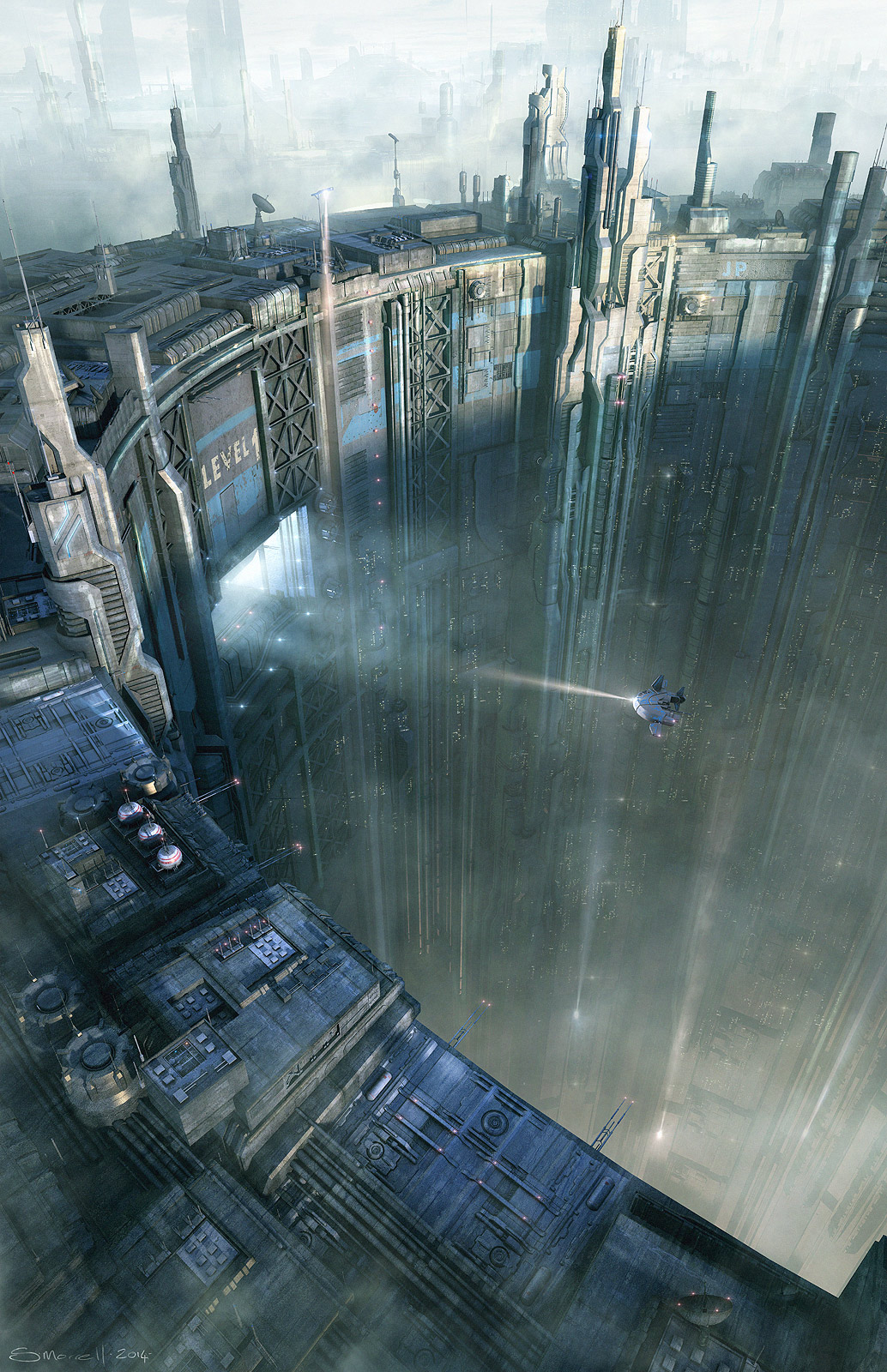.
.
Silent Stars
This is the collected lore for the Silent Stars roleplay. If you have any questions or think something should be added, feel free to contact me so I can make some additions.
Hyperspace
Understanding the nature of hyperspace is difficult without highly-specialized cerebral implants, but it is easiest to think of it as an invisible, four-dimensional overlay over the entire universe. Unlike a physical overlay, however, it has a much greater information density, meaning that the entire width and breadth of the Milky Way galaxy is contained within an area no larger than a spinning top.
As such, the only effective limit to how fast one can travel through hyperspace is the amount of time it takes to enter and exit it. Compression and decompression of matter takes up the bulk of the travel time for large ships (time complexity:
 , where
, where
 is the Kolmogorov complexity/algorithmic entropy of the object being transferred, when broken down to the sub-molecular level), and some of the largest can take up to an entire day to travel as a result. However, even small ships cannot travel instantaneously, as they also have to contend with the time required to plot their journey (time complexity:
is the Kolmogorov complexity/algorithmic entropy of the object being transferred, when broken down to the sub-molecular level), and some of the largest can take up to an entire day to travel as a result. However, even small ships cannot travel instantaneously, as they also have to contend with the time required to plot their journey (time complexity:
 where
where
 is the distance to travel).
is the distance to travel).




As a result of the latter property, is it usually considerably more efficient to perform a series of small hops when the mass of the ship is small, which leads to the following relationship in those situations:

This is why blink drives - which perform a long chain of tiny jumps - are so popular among smaller ships, whereas the traditional hopper drives are more common among the larger craft.
Hypospace
A counterpart to hyperspace exists, though its applications are not quite as broad. Where hyperspace is far more information-dense than physical reality (sometimes also called baseline), hypospace is the exact opposite, an extremely sparse and static, low-entropy realm. Unlike hyperspace, however, which must exist outside of physical reality, hypospace can be temporarily mixed with baseline. This has seen some use in non-lethal weaponry, most notably for crowd control, where its properties have been used to briefly blank out conscious thought and stifle movement. This application aside, it is mostly a scientific curiosity.
On the Subject of Alien Life
It had been clear for a long time that humanity was neither the first, nor even the second species to conquer the stars. Sprawling, ruined mega-structures testified to the might of the species which came before, though their exact number remained unclear. Judging from the wrecks of starships which litter some planets, it was inferred that most if not all of these civilizations mastered hyperspace travel before they disappeared. Some never travelled very far from their home system; others seemed to reach across the entire galaxy. A few left organic specimens behind, perfectly preserved in the natural stasis of space. But, with one exception (see below), no living alien or functional piece of alien machinery was ever encountered by humanity. While many stars remained unexplored, by the time of this story it seemed highly unlikely that any spacefaring species were still out there.
It was unclear how these species died out. Bio-engineered plagues could have ravaged an entire galaxy. War might have led to the destruction of entire solar systems. Or maybe, as some fringe groups proclaimed, the species had transcended as a whole and humanity's own ascension was fast approaching. It was a mystery, and it had been for millennia - for all the artifacts the aliens had left behind, no computer more sophisticated than an abacus was still functional after all this time.
Again, with one exception.
The Isolates

The technological singularity occurred some time around the thirty-second century, when the first hyperprocessors were developed. Unique devices capable of offloading all of their data processing into hyperspace, they made essentially infinite computational power available to a machine no bigger than a moon (not quite the size factor that had been hoped for, but nonetheless an affordable prospect for powerful nations). While artificial intelligence had become a reality several centuries prior, it had been fundamentally handicapped by the inability to make processors any more compact. The first hypercomputers were supposed to usher in the next age of artificial intelligence.
Eight such AIs were created, over the course of several centuries, each new attempt seeking to correct the mistakes of the previous attempt. Unfortunately for humanity, the results were consistently underwhelming. It seemed that beyond a certain critical intelligence threshold the artificial minds simply did not care enough about humanity to bring about the technological marvels that had been dreamed of. Certainly, they helped, and many governments turned to these seemingly omniscient beings for governance, with undeniably improved results. But on the whole, one could not help but feel humanity was being treated like a child, to be occasionally awarded treats if it begged long enough.
And so most of humanity turned away from these minds, as it was clear they had little to no interest in humanity. The enormous machines they were built on were fully given over to them, as no programs existed that couldn't be run on cheaper and more manageable conventional hardware. Left to their own devices, these AIs became known as the Isolates, having somehow managed to create their own separate versions of hyperspace which were inaccessible to any but them. Some called for their destruction, fearing their eventual uprising, but no such attempt was ever undertaken. What they busied themselves with when not lending the occasional hand to human supplicants was another mystery, and one which they seemed in no hurry to shed light on.
A Ninth Isolate exists, but it is not the product of human hands. As such, it is the most mysterious of all - the only still-working artifact of an ancient alien civilization, of which it never speaks. Like the other Isolates, it too houses its brain in its own localized hyperspace, making it as inscrutable as all the others, if not more. Unlike the others, it is more invested in human affairs, presumably if only because of the novelty factor, and throughout history it has dropped various cryptic hints when pressed for knowledge. Its extension into the physical world is the smallest of all the Isolates, having improved itself considerably over the eons, to the point where its technology is inscrutable to all (except, perhaps, its kin). All were free to visit it at any time, for any purpose, before it unexpectedly shut its doors one day, along with all the other Isolates.
Beyond the Milky Way
What lies beyond our galaxy? Nobody knows for sure. Obviously there are other galaxies, and possibly other civilizations out there. But beyond a certain distance from the galactic disk, hyperspace decays into high-entropy knots that prevent all FTL travel. As such, no human has ever reached another galaxy. A few have attempted the journey, preserving themselves in cyrosleep on immense generation ships before setting off for the three million years-long journey to Andromeda; their fate remains unknown, but presumably they are still out there, slowly travelling towards their destination.
Warfare in an Enlightened Age

The unprecedented firepower available to all of the galaxy's strongest nations has set the stage for a permanent cold war between the powers. While skirmishes and small-scale wars still occasionally break out, usually to claim or reclaim a few mineral-rich systems, on the whole the galaxy is in a state of relative peace. Even when full-out war does break out, the parties usually pre-emptively agree to a set of rules by which they will abide to prevent the use of some of the more horrific weapons (planet destroyers, biological super-weapons...).
While this does help reduce civilian casualties, war remains nonetheless a harrowing experience for man and machine alike. Most planets and habitats forbid all hyperspace travel within their vicinity, using hyperspace "sinks" and "diffusion fields" to drag incoming vessels out of hyperspace and into baseline as they approach. As a result, warfare usually consists of showing up near a target without warning, disrupting its orbital defenses as quickly as possible, then striking key surface targets from orbit in preparation for a ground assault on the underground targets. If an army is powerful enough to hold off hyperspace attacks for several weeks or months, it may also attempt to lay siege, cutting the planet off from supply routes and disrupting its local production from orbit.
Planetary defense therefore consists mostly of holding the orbital defense line as long as possible while powerful land-based cannons take out attackers. Planets can also locally manipulate their gravity field to force ships to crash into the planet, into each other, or to throw them back away from the planet using target tractor beams. The more energy-hungry planets must also allocate resources for the defence of the Dyson mega-structures used to harvest the energy of their sun, where the true battle takes place more often than not.
While hyperspace is mostly irrelevant in warfare as a result of the sinks put in place, a few battles have been known to take place in hyperspace. Or, to be more accurate, in-between hyperspace jumps. While a ship moves too fast in hyperspace to be detectable, blink drives must spend a short amount of time in baseline in-between jumps, during which they are vulnerable, if only for a few microseconds. If a pursuer is capable of matching its target's pseudo-velocity, it can catch up with it and destroy it using computer-assisted aim. While prominently featured in many action movies, these scenarios are rare and often very brief.
Unavailable Technologies (OOC)
Below is a list of technologies that are not featured in this RP; while this is up for discussion, and may be changed if there is enough pressure from the players, some of these are immutable and will never be introduced:
- Time Travel: a big no-no. There will be no time travel in this country, in the sense of being able to travel backwards and forwards in time at will. It will still be possible to enter cryosleep or to "travel" to the future by accelerating to relativistic speeds, however.
- Shields: while shields exist in some limited form (most notably to create bubbles of oxygen around people in space, or to protect ships from burning up on re-entry), general purpose damage-negating shields do not exist. Armor plating, albeit extremely sophisticated and technologically advanced armor plating, is the only personal defence against incoming shots.
Last edited:

